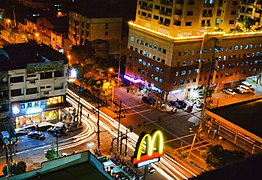Abad Santos Avenue
History
Abad Santos Avenue was originally built in the early 19th century under Spanish rule as a narrow residential street in the pueblo of Tondo called Calle Manuguit. The street was believed to have been named after a pre-Hispanic ruling clan of Tondo whose members included Don Agustin Manuguit, a local minister who participated in the Revolt of the Lakans. It was extended south to Barrio Palomar to link with Calle Palomar from just south of Calle Mayhaligue to its terminus at Calle Azcarraga (now Recto Avenue). In 1955, through Republic Act 1256, Manuguit Street was renamed in honor of José Abad Santos, Chief Justice of the Supreme Court of the Philippines, who was executed by the Japanese invading forces during World War II.
Route
Abad Santos Avenue begins at a split from Rizal Avenue just south of Hermosa Street near the San Jose Manggagawa de Manuguit Church and the Manila Chinese Cemetery at Tondo's border with Santa Cruz district. It runs south across the mostly residential area of Manuguit, crossing Solis Street and the Philippine National Railways line at Antipolo Street. The avenue then enters the Tayuman area and intersects with Yuseco Street (formerly Calle Tayabas), Tayuman Street (Calle Morga), and Quiricada Street. South of Bambang Street (Calle Trozo), Abad Santos traverses the Tutuban area that is home to Seng Guan Temple, Chiang Kai Shek College, the Philippine Cultural College, as well as General Hizon Elementary School and Gregorio del Pilar Elementary School. The road ends at the junction with Recto Avenue (Calle Azcarraga), close to the Divisoria shopping district.
Abad Santos Avenue has a short extension into Binondo and Plaza San Lorenzo Ruíz south of Recto Avenue as Reina Regente Street. It is served by Abad Santos station at Rizal Avenue.
Intersections
The entire route is located in Manila.
| km | mi | Destinations | Notes | ||
|---|---|---|---|---|---|
| Northern terminus. Traffic light intersection. Continues north as | |||||
| Morong Street | Unsignaled intersection. | ||||
| Dinalupihan Street | Northbound only. | ||||
| Corregidor Street | Southbound only. | ||||
| Solis Street | Traffic light intersection. | ||||
| Tecson Street | Traffic light intersection. | ||||
| Antipolo Street, Old Antipolo Street | Traffic light intersection. Railroad crossing. | ||||
| Batangas Street | Unsignaled intersection. | ||||
| Yuseco Street | Traffic light intersection. | ||||
| Traffic light intersection. | |||||
| Villaruel Street | |||||
| Quiricada Street | Traffic light intersection. | ||||
| Bambang Street / Bambang Extension | Traffic light intersection. | ||||
| G. Araneta Street | Northbound only. | ||||
| Mayhaligue Street | Traffic light intersection. | ||||
| La Torre Street | |||||
| Padre Algue Street | Traffic light intersection. | ||||
| Southern terminus. Traffic light intersection. Continues southward as Reina Regente Street. | |||||
| 1.000 mi = 1.609 km; 1.000 km = 0.621 mi | |||||
Photos
-
Bambang Street-Abad Santos Avenue intersection
-
Bambang Street-Abad Santos Avenue intersection at night
-
Philippine Cultural College in between Recto Avenue and Padre Algue Street
-
Calesa plying the avenue, near Quiricada Street-Abad Santos Avenue intersection
References
- ^ "North Manila". Archived from the original on June 6, 2020. Retrieved May 23, 2020.
- ^ "Andres Bonifacio: Biographical notes. Part I: 1863-1891 - Katipunan: Documents and Studies". www.kasaysayan-kkk.info. p. 10. Retrieved November 16, 2017.
... in the Tondo barrio of Palomar, which was situated on an estero-ringed island just to the east of Tutuban.
- ^ Republic Act No. 1256 (June 10, 1955), "An Act Changing The Name Of Manuguit Street, A National Highway In The City Of Manila, To Jose Abad Santos Street", LawCenter Philippines, archived from the original on December 19, 2013, retrieved May 16, 2020



